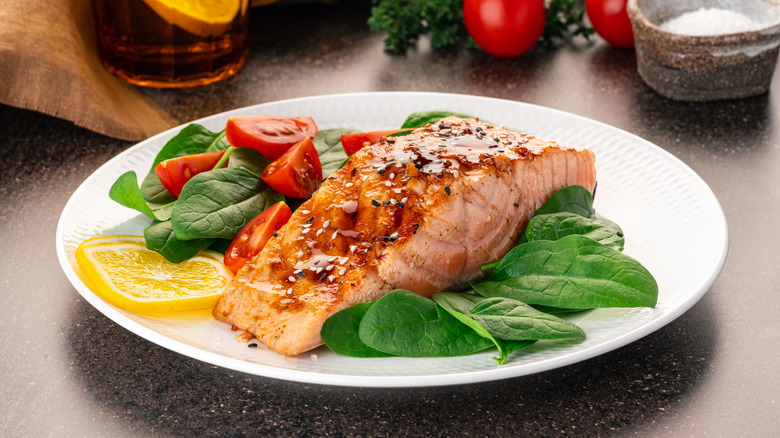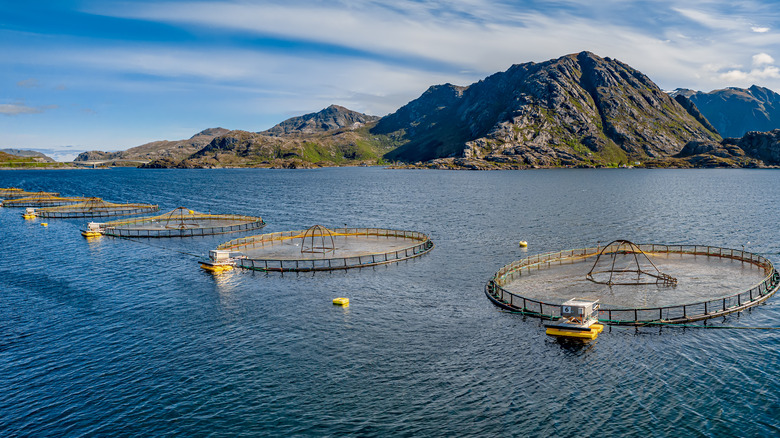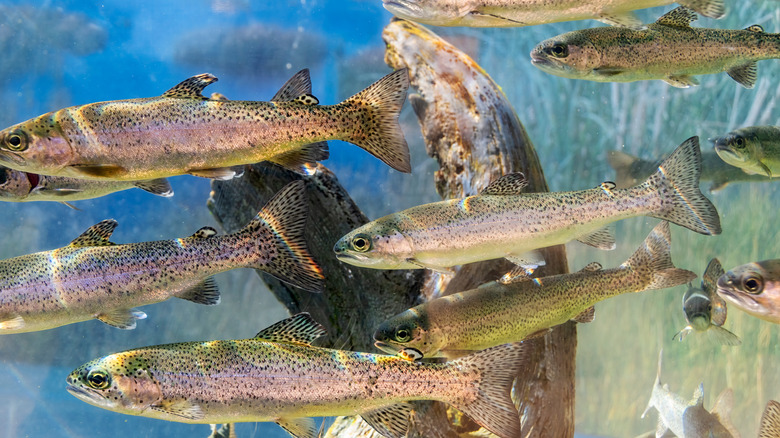Why The Price Of Salmon May Soon Increase
Your morning lox bagel might be in for a shock. It's no secret that overseas trade has been something of a rollercoaster since the start of 2022. Import restrictions incited by the Russia-Ukraine conflict have already limited global access to seafood, causing fish and shellfish prices to skyrocket. Now, salmon is about to see a significant price increase — but the overseas conflict isn't the only reason to blame.
Per Salmon Business, the US consumes around 400,000 tons of salmon every year. King (aka "Chinook") Salmon is the largest type of salmon in the Pacific, according to Chef's Resources. Its higher fat content makes for a luxuriously flaky texture and offsets the gamey flavor of other wild salmon breeds. Per Food and Wine, the average king salmon clocks in at around 40 pounds, but a single fish can grow to 135 pounds.
On March 11, The White House released an official statement outlining new behavior for foreign trade and international relations, in order to avoid perceived partisanship to either side of the Russia-Ukraine conflict. The plan effectively bans US imports of select goods from Russia, including seafood. This ban will deny an estimated $1 billion in revenue funds from the Russian seafood market, but it also means salmon will be substantially less accessible -– and pricier –- for consumers in the US. Now, another perhaps unexpected culprit is surfacing to impact your salmon prices: the waters they live in.
Rising temperatures are affecting New Zealand waters
Climate change has dramatically impacted the aquaponics industry. Grant Rosewarne, New Zealand King Salmon chief executive, reports that New Zealand farms are responsible for roughly 85% of the global salmon supply, via The Guardian. This summer, he says, New Zealand water temperatures will have risen by a full degree, which is a massive shock to the homeostasis and wellbeing of the salmon population. "I've often said we're a bit like the canary in the coal mine, when it comes to global warming," Rosewarne says, via New Zealand news outlet RNZ. "We've got a cold water species that's very susceptible to half a degree change or one degree change."
According to UC San Diego, a "marine heatwave" is a period of unusually high water temperatures in a given area. Its defining features are duration and intensity and marine heatwaves don't only affect the fish inhabiting these warmer waters. Uncharacteristically high water temperatures can also prevent the food supply these organisms rely on from growing and impact the migration patterns of migratory fish –- like salmon.
What this means for consumers
Not only does the migration of salmon determine the populations of the fish, it also provides a relied-upon food source for eagles and bears living in the areas through which the schools pass. So, any changes in the salmon migration could lead to fallout that affects the food web of an entire ecosystem.
Rosewarne estimates that 42% of fish in the company's farms have died from high water temperatures in 2022, compared to only 17% in 2018. Farms are reportedly losing salmon by thousands of tons. RNZ reports that 1,269 metric tons of dead salmon were hauled by the truckload to landfills between December and February alone. And in the month of February, 632 metric tons of salmon were lost, compared to 90 metric tons in February 2021.
Not even halfway through the year, the New Zealand salmon industry has already seen a net loss of over $55 million. In the wake of this massive loss, New Zealand King Salmon will temporarily close three of its four farms, per The Guardian, with plans to relocate farming operations to cooler waters if given government approval.


